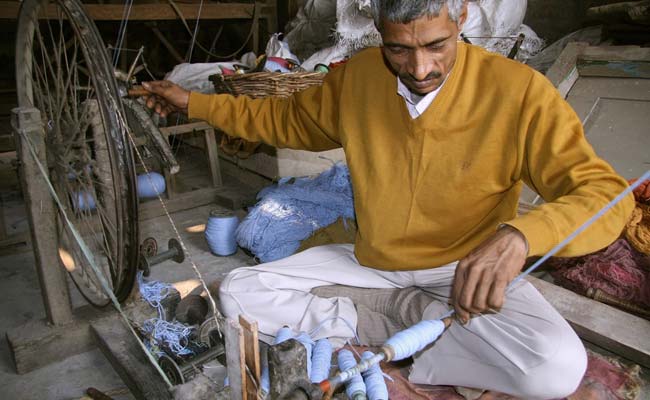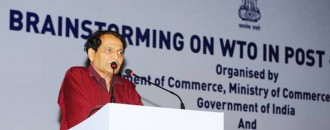
Can Varanasi’s Trade Facilitation Centre lift India’s Handloom Sector?
The move to provide finance and a platform to get international buyers is a beginning, the handloom sector needs much more support to recover Bidhu Bhushan Palo | @TheDollarBiz  In one of the last few advises, Mahatma Gandhiji said this about confusion in minds: “Recall the face of the poorest and the weakest man whom you may have seen, and ask yourself, if the step you contemplate is going to be of any use to him. Will he gain anything by it? Will it restore him to a control over his own life and destiny? In other words, will it lead to swaraj [freedom] for the hungry and spiritually starving millions? Then you will find your doubts and your self melt away." However, an overview of the recently launched Trade Facilitation Centre (TFC) in Bada Lalpur, Varanasi, does not clear any concerns on India’s handloom sector. A look at the handloom sector export numbers shows that exports of several products under handloom fabrics have declined. For example, India’s exports of handloom sarees stood at around Rs.1.38 crore in FY2013-14, which is down almost 80% from around Rs.6.76 crore in the previous year. The government says that India’s total textile exports managed to recover to around $39.3 billion in FY2013-14, which is up about 12.5% from the previous year and a significant increase from the 5.32% decline seen in the previous year. The government expects textile exports to grow again to $45 billion in FY2014-15, a jump of around 14.5%. However, the handloom sector continues to be entangled in a knotty situation. According to the Ministry of Textiles, handloom production is expected to decline 4% to around 1,116 million sq. m. in FY2014-15, compared to increases seen in all other sectors: mill (6%), powerloom (3%), and hosiery (7%). Meanwhile, the share of handloom in total textile production is expected to shrink to 10%, which is less than half of the 23% share in FY1995-96. Unsurprisingly, handloom weavers are increasingly abandoning their villages for other jobs in cities. According to official estimates, the total weaver household units have declined from 29.9 lakh in the first census in 1987 to 22.6 lakh in the third census in 2009-10. At the launch of the TFC, the Minister of Textiles said that the government is aware of the struggles of handloom weavers and efforts are on to renew their faith in the sector. So can the TFC change this? Prime Minister Narendra Modi believes it can. He said modernisation, financial support, skill development and service could help solve problems, and the TFC can aid in all this. Speaking at the launch of the Trade Facilitation Centre, PM Modi said, “Benares saree has a high brand reputation. It is estimated that there will be 20 crore weddings in the coming years and we must ensure that the 20 crore benares sarees are fulfilled in India and not by ‘artificial sarees’ (from China?).” He added that with an assured market like this, the only thing required is service and the Trade Facilitation Centre will help achieve this. But is it really so? It is not rocket science to figure out the problems of the handloom industry. The most important challenge is competition; it is massive competition for Indian handloom weavers. First, they compete locally among themselves, then with powerlooms, and finally with handlooms and powerlooms in other countries. This competition is at all stages: for funds, for raw materials, in designs, and markets. The Trade facilitation Centre can help but requires a multi-pronged approach, and here is where PM Modi’s most important words come: “This Trade Facilitation Centre is for you. Do anything that is required to strengthen the sector.” Given the liberty, to be effective, the TFC must become a centre of low priced raw materials, machinery and training for handloom weavers. It must eliminate the involvement of middlemen. National institutes such as NIFT can conduct regular sessions in design, technology development, and marketing, and be a contact centre for local artisans and sellers. There is a need to have a R&D centre to develop products such as a motorised charkha (spindle). And a huge push is required in e-commerce, as the PM said. These steps could not just help make the TFC at Benares a hub in Eastern India, but also turn it into a model like AMUL for the rest of India to emulate. As of now, we do have a government website (www.cottageemporium.in) to promote handlooms, but how many of us know about it or like to use it?
In one of the last few advises, Mahatma Gandhiji said this about confusion in minds: “Recall the face of the poorest and the weakest man whom you may have seen, and ask yourself, if the step you contemplate is going to be of any use to him. Will he gain anything by it? Will it restore him to a control over his own life and destiny? In other words, will it lead to swaraj [freedom] for the hungry and spiritually starving millions? Then you will find your doubts and your self melt away." However, an overview of the recently launched Trade Facilitation Centre (TFC) in Bada Lalpur, Varanasi, does not clear any concerns on India’s handloom sector. A look at the handloom sector export numbers shows that exports of several products under handloom fabrics have declined. For example, India’s exports of handloom sarees stood at around Rs.1.38 crore in FY2013-14, which is down almost 80% from around Rs.6.76 crore in the previous year. The government says that India’s total textile exports managed to recover to around $39.3 billion in FY2013-14, which is up about 12.5% from the previous year and a significant increase from the 5.32% decline seen in the previous year. The government expects textile exports to grow again to $45 billion in FY2014-15, a jump of around 14.5%. However, the handloom sector continues to be entangled in a knotty situation. According to the Ministry of Textiles, handloom production is expected to decline 4% to around 1,116 million sq. m. in FY2014-15, compared to increases seen in all other sectors: mill (6%), powerloom (3%), and hosiery (7%). Meanwhile, the share of handloom in total textile production is expected to shrink to 10%, which is less than half of the 23% share in FY1995-96. Unsurprisingly, handloom weavers are increasingly abandoning their villages for other jobs in cities. According to official estimates, the total weaver household units have declined from 29.9 lakh in the first census in 1987 to 22.6 lakh in the third census in 2009-10. At the launch of the TFC, the Minister of Textiles said that the government is aware of the struggles of handloom weavers and efforts are on to renew their faith in the sector. So can the TFC change this? Prime Minister Narendra Modi believes it can. He said modernisation, financial support, skill development and service could help solve problems, and the TFC can aid in all this. Speaking at the launch of the Trade Facilitation Centre, PM Modi said, “Benares saree has a high brand reputation. It is estimated that there will be 20 crore weddings in the coming years and we must ensure that the 20 crore benares sarees are fulfilled in India and not by ‘artificial sarees’ (from China?).” He added that with an assured market like this, the only thing required is service and the Trade Facilitation Centre will help achieve this. But is it really so? It is not rocket science to figure out the problems of the handloom industry. The most important challenge is competition; it is massive competition for Indian handloom weavers. First, they compete locally among themselves, then with powerlooms, and finally with handlooms and powerlooms in other countries. This competition is at all stages: for funds, for raw materials, in designs, and markets. The Trade facilitation Centre can help but requires a multi-pronged approach, and here is where PM Modi’s most important words come: “This Trade Facilitation Centre is for you. Do anything that is required to strengthen the sector.” Given the liberty, to be effective, the TFC must become a centre of low priced raw materials, machinery and training for handloom weavers. It must eliminate the involvement of middlemen. National institutes such as NIFT can conduct regular sessions in design, technology development, and marketing, and be a contact centre for local artisans and sellers. There is a need to have a R&D centre to develop products such as a motorised charkha (spindle). And a huge push is required in e-commerce, as the PM said. These steps could not just help make the TFC at Benares a hub in Eastern India, but also turn it into a model like AMUL for the rest of India to emulate. As of now, we do have a government website (www.cottageemporium.in) to promote handlooms, but how many of us know about it or like to use it?
This blog was published on November 25, 2014.





 to success.
to success.